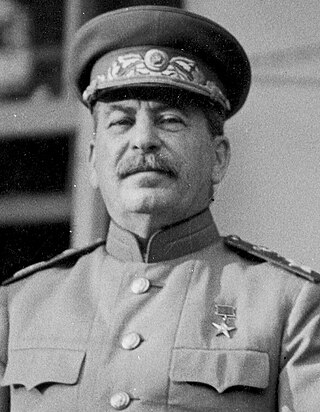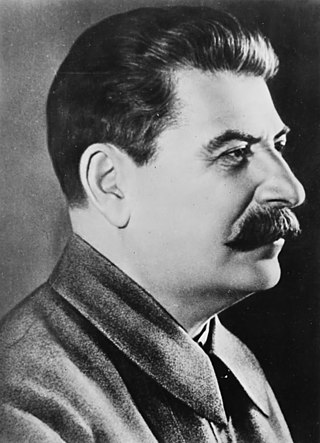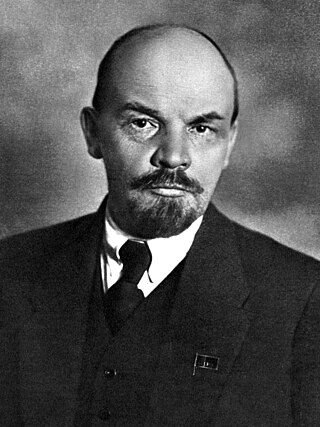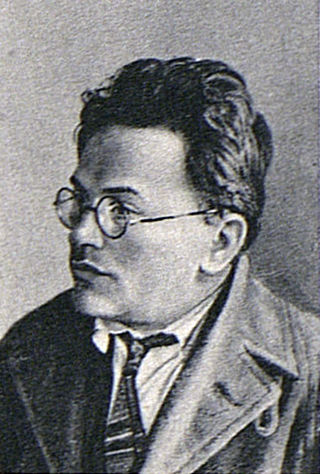
Joseph Vissarionovich Stalin was a Soviet revolutionary and politician who was the longest-serving leader of the Soviet Union from 1924 until his death in 1953. He held power as General Secretary of the Communist Party of the Soviet Union (1922–1952) and Chairman of the Council of Ministers of the Soviet Union (1941–1953). Stalin initially governed the country as part of a collective leadership before consolidating power to become a dictator by the 1930s. Stalin coined the term Marxism–Leninism to outline his Leninist interpretation of Marxism, also known as Stalinism.

Lev Davidovich Bronstein, better known as Leon Trotsky, was a Russian revolutionary, Soviet politician, journalist, and political theorist. He was a central figure in the 1905 Revolution, October Revolution, Russian Civil War, and the establishment of the Soviet Union. Alongside Vladimir Lenin, Trotsky was widely considered the most prominent Soviet figure and was de facto second-in-command during the early years of the Russian Soviet Republic. Ideologically a Marxist and a Leninist, his thought and writings inspired a school of Marxism known as Trotskyism.

Leninism is a political ideology developed by Russian Marxist revolutionary Vladimir Lenin that proposes the establishment of the dictatorship of the proletariat led by a revolutionary vanguard party as the political prelude to the establishment of communism. Lenin's ideological contributions to the Marxist ideology relate to his theories on the party, imperialism, the state, and revolution. The function of the Leninist vanguard party is to provide the working classes with the political consciousness and revolutionary leadership necessary to depose capitalism.

Stalinism is the totalitarian means of governing and Marxist–Leninist policies implemented in the Soviet Union (USSR) from 1927 to 1953 by dictator Joseph Stalin. Stalin had previously made a career as a gangster and robber, working to fund revolutionary activities, before eventually becoming General Secretary of the Soviet Union. Stalinism included the creation of a one man totalitarian police state, rapid industrialization, the theory of socialism in one country, forced collectivization of agriculture, intensification of class conflict, a cult of personality, and subordination of the interests of foreign communist parties to those of the Communist Party of the Soviet Union, which Stalinism deemed the leading vanguard party of communist revolution at the time. After Stalin's death and the Khrushchev Thaw, a period of de-Stalinization began in the 1950s and 1960s, which caused the influence of Stalin's ideology to begin to wane in the USSR.

Mikhail Ivanovich Kalinin was a Soviet politician and Russian Old Bolshevik revolutionary. He served as head of state of the Russian Soviet Federative Socialist Republic and later of the Soviet Union from 1919 to 1946. From 1926, he was a member of the Politburo of the Communist Party of the Soviet Union.

Nadezhda Konstantinovna Krupskaya was a Russian revolutionary and the wife of Vladimir Lenin.

Lenin's Testament is a document dictated by Vladimir Lenin in late 1922 and early 1923. In the testament, Lenin proposed changes to the structure of the Soviet governing bodies. Sensing his impending death, he also gave criticism of Bolshevik leaders Zinoviev, Kamenev, Trotsky, Bukharin, Pyatakov and Stalin. He warned of the possibility of a split developing in the party leadership between Trotsky and Stalin if proper measures were not taken to prevent it. In a post-script he also suggested Joseph Stalin be removed from his position as General Secretary of the Russian Communist Party's Central Committee. Although there are some historical questions regarding the document's origins, the majority view is that the document was authored by Lenin.

Vyacheslav Rudolfovich Menzhinsky was a Bolshevik revolutionary, Soviet statesman and Communist Party official who served as chairman of the OGPU from 1926 to 1934. He was master of more than 10 languages.
The Ryutin affair was an attempt led by Martemyan Ryutin to remove Joseph Stalin as General Secretary of the All-Union Communist Party (b) (CPSU) in 1932.
Dmitri Antonovich Volkogonov was a Soviet and Russian historian and colonel general who was head of the Soviet military's psychological warfare department. After research in secret Soviet archives, he published a biography of Joseph Stalin and Vladimir Lenin, among others such as Leon Trotsky. Despite being a committed Stalinist and Marxist–Leninist for most of his career, Volkogonov came to repudiate communism and the Soviet system within the last decade of his life before his death from cancer in 1995.

Vladimir Ilyich Ulyanov, better known as Vladimir Lenin, was a Russian revolutionary, politician, and political theorist. He served as the first and founding head of government of the Russian Soviet Federative Socialist Republic from 1917 until his death in 1924, and of the Soviet Union from 1922 until his death. Under his administration, Russia, and later the Soviet Union, became a one-party socialist state governed by the Communist Party. Ideologically a Marxist, his developments to the ideology are called Leninism.

Joseph Stalin started his career as a radical student, becoming a robber, gangster as well as an influential member and eventually the leader of the Bolshevik faction of the Russian Social Democratic Labour Party. He served as the General Secretary of the Central Committee of the Communist Party of the Soviet Union from 1922 until his death in 1953.

The 1907 Tiflis bank robbery, also known as the Erivansky Square expropriation, was an armed robbery on 26 June 1907[a] in the city of Tiflis in the Tiflis Governorate in the Caucasus Viceroyalty of the Russian Empire. A Bolshevik group "expropriated" a bank cash shipment to fund their revolutionary activities. The robbers attacked a bank stagecoach, and the surrounding police and soldiers, using bombs and guns while the stagecoach was transporting money through Erivansky Square between the post office and the Tiflis branch of the State Bank of the Russian Empire. The attack killed forty people and injured fifty others, according to official archive documents. The robbers escaped with 241,000 rubles.

Mikhail Vasilyevich Frunze was a Soviet revolutionary, politician, army officer and military theorist. Born to a Bessarabian father and a Russian mother in Russian Turkestan, Frunze attended the Saint Petersburg Polytechnical University and became an active member of the Russian Social Democratic Labour Party (RSDLP). Following the RSDLP ideological split, he sided with Vladimir Lenin's Bolshevik faction. He led the textile workers strike in Ivanovo during the 1905 Russian Revolution, for which he was later sentenced to death before being commuted to life-long hard labour in Siberia. He escaped ten years later and took active part in the 1917 February Revolution in Minsk and the October Revolution in Moscow.

Lev Borisovich Kamenev was a Russian revolutionary and Soviet politician. He was born in Moscow to parents who had both been involved in revolutionary politics in the 1870s. He joined the Russian Social Democratic Labour Party (RSDLP) in 1901 and was active in Moscow and Saint Petersburg. Kamenev participated in the failed Russian Revolution of 1905. Relocating abroad in 1908, he became an early member of the Bolsheviks and a close associate of the exiled Vladimir Lenin. In 1914, he was arrested upon returning to Saint Petersburg and exiled to Siberia. Kamenev was able to return after the February Revolution of 1917, which overthrew the Tsarist monarchy. In 1917, he served briefly as the equivalent of the first head of state of the All-Russian Congress of Soviets. He disagreed with Lenin's strategy of armed uprising during the October Revolution but nevertheless remained in a position of power after the fall of the Provisional Government. In 1919, Kamenev was elected a full member of the first Politburo.

Alexei Ivanovich Rykov was a Russian Bolshevik revolutionary and a Soviet politician and statesman, most prominent as premier of Russia and the Soviet Union from 1924 to 1929 and 1924 to 1930 respectively. He was one of the accused in Joseph Stalin's show trials during the Great Purge.
The Left Opposition was a faction within the Russian Communist Party (Bolsheviks) from 1923 to 1927 headed de facto by Leon Trotsky. The Left Opposition was formed by Trotsky to mount a struggle against the bureaucratic degeneration that began within the party leadership headed by Stalin during the serious illness of the Bolshevik founder Vladimir Lenin. The degeneration intensified after Lenin's death in January 1924.

Under the leadership of Russian communist Vladimir Lenin, the Bolshevik Party seized power in the Russian Republic during a coup known as the October Revolution. Overthrowing the pre-existing Provisional Government, the Bolsheviks established a new administration, the first Council of People's Commissars, with Lenin appointed as its governing chairman. Ruling by decree, Lenin’s Sovnarkom introduced widespread reforms confiscating land for redistribution among the permitting non-Russian nations to declare themselves independent, improving labour rights, and increasing access to education.

Georgy Ivanovich Safarov was a Bolshevik revolutionary and politician who was a participant in the Russian Revolution, the Russian Civil War, and in the executions of the Romanovs in Yekaterinburg and Alapayevsk.

De-Leninization is political reform aimed at refuting Leninist and Marxist–Leninist ideology and ending the personality cult of Vladimir Lenin. Examples include removing images and toppling statues of Lenin, renaming places and buildings, dismantling Lenin's Mausoleum currently in Red Square, Moscow, and burying his mummified corpse.





















